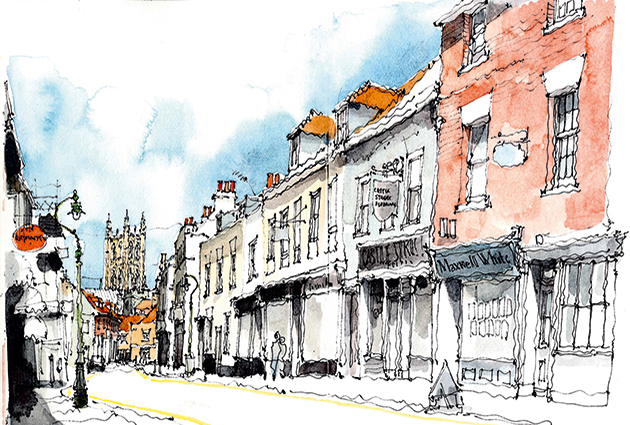A threat to the Canterbury skyline
A new hotel threatens the enchanting skyline of Canterbury, argues Ptolemy Dean


By Ptolemy Dean
Even before the martyrdom of St Thomas à Becket made Canterbury a major destination of pilgrimage, the great bulk of its cathedral must have exerted an irresistible presence over the narrow streets of the surrounding city. Today, the three towers of the building dominate the whole scene. There are two towers at the western end of the building —which were controversially made to match in the 19th century—and the magnificent Bell Harry over the central crossing. Bell Harry was constructed in 1498 by John Wastell, the mason who also created the fan-vaulted ceiling of Kings College Chapel, Cambridge. Tall pinnacles compensate for the absence of a spire.
These towers are at precisely the right scale to command the streetscape of the city. They also come in and out of view in the most majestic way, rising above rooflines— sometimes together, but more often one at a time—and then completely disappearing. It is enticing and teasing and makes a walk through the city rewarding and stimulating.
By far the best place to see this effect is on the route from the city wall to the cathedral along Castle Street (see illustration), St Margaret’s Street and Mercery Lane. Although this route is barely half a mile in length, the various cathedral towers rise up and disappear from view no less than six times, which must be a record in any cathedral city.
The survival of this astonishing city experience is all the more miraculous when one considers the destruction of about one-third of ancient Canterbury as a result of Second World War bombing and 1960s redevelopment.
What makes this sequence of views so captivating, moreover, is the moving progression of changing relationships, caused by the gentle, curving alignments and dog-leg layout of the medieval streets. Much of this must be down to happenstance and serendipity, but it could never be re-created now. A dead-straight axis of the modern type would have none of the sophistication, subtlety and suspense that this wonderful and constantly evolving approach offers.
However, if one is to remain spellbound along the full length of this route, it is essential that those skyline areas where the cathedral is out of view are as carefully protected as those locations where it is in view. In other words, for the towers to dance across the city skyline most effectively, they need an empty stage from which to appear.
Exquisite houses, the beauty of Nature, and how to get the most from your life, straight to your inbox.
The importance of that empty stage is a lesson that has been tragically driven home in London by some calamitous planning decisions. Here, Sir Christopher Wren’s no less brilliant placing of the dome of St Paul’s Cathedral, such that it frames views down Fleet Street and Ludgate Hill, has, since 2014, been irretrievably compromised by the appearance of an angular office block popularly known as the Cheesegrater. It is as if a heckler had got up on stage and screamed during a scene change. The magic has been utterly destroyed.
Now, Canterbury will perpetuate the same mistake by allowing a tall modern hotel to be constructed where Castle Street turns into St Margaret’s Street. What is worse is that it is the council itself that owns the site. The new hotel will be a modern block that rises above the old houses in front of it and intrudes upon the view, breaking the spell set by Wastell and others over Castle Street all those centuries ago.
As in London, one intrusion is often used to justify others and so this may just be the start of a wider process of visual erosion. Historic England (the new name for English Heritage) has acknowledged that the hotel would ‘harm’ the Canterbury cityscape, but—as at St Paul’s—with no actual view of the cathedral physically obstructed, it failed to articulate the value of empty sky.
In this omission, a crucial element of our experience of cities is left unrecognised. Canterbury City Council could yet modify the design of its new hotel to reduce its impact. Perhaps the councillors should take a stroll down London’s Fleet Street to see the potentially lamentable consequences of failing to do so?
Image by Ptolemy Dean
